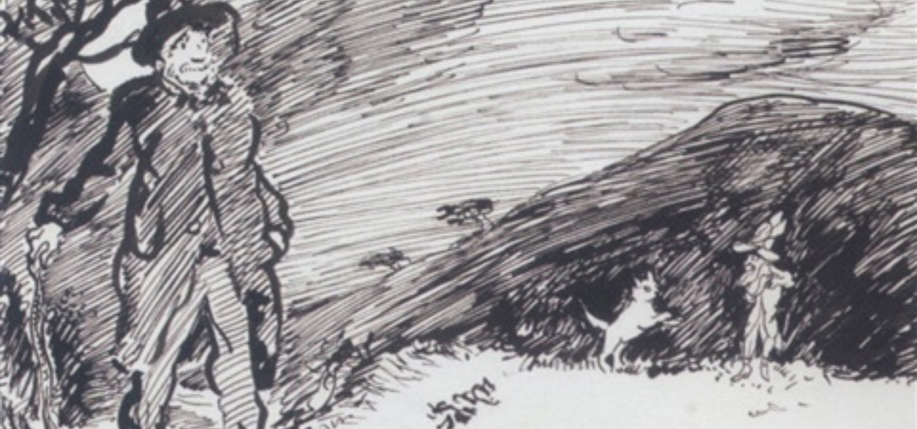The history of April Fools’ Day and tricksters of folk mythology.
℘℘℘
April is full of surprises. When spring sunshine starts warming the earth, night can fall on a brown leafless landscape and day break to green grass and golden flowers splashing the garden with color. A balmy day can suddenly turn cold, gray, and rainy. As the weather capriciously switches from sunshine to storm, Mother Nature seems to be playing a colossal joke on us. How appropriate then, that April opens with a celebration given to light-hearted jesting called All Fools’ Day.
Some scholars say that April’s name derives from the Latin aperire, meaning “to open,” alluding to buds opening on trees and flowers. Others point out that the Romans named months after divinities, and because most animals mate in the spring, April was sacred to Venus, the Roman goddess of love. This leads some scholars to suggest that the Romans named the month Aphrilis after the goddess’s Greek equivalent, Aphrodite. During the Veneralia festival on the first of the month, lovers ordered each other to perform senseless tasks to prove that love, which makes fools of both commoners and kings, rules over logic. The Greek spring festival of Cerealia may be the origin of “the fool’s errand,” as it recalls how the goddess Ceres fruitlessly followed the echo of her daughter’s scream when the girl was abducted by the god of the Underworld.
The modern tradition of April Fooling probably began in France. The Roman calendar had marked January 1 as the beginning of the new year long before Christ’s birth, but the medieval Church chose March 25, the Feast of the Annunciation, as its new year celebration. Exactly nine months before Christmas, the day commemorated the angel’s announcement to Mary that she would bear a son.
Like many festivals of the middle ages, the Church’s New Year was celebrated for a week. On the final day, April 1, people exchanged gifts and best wishes for the coming months. In 1564, Charles IX of France decreed his nation would return to the Roman tradition of starting the year on January 1st. But habits die hard, and the French were slow to accept the change. Eventually, jokers began making fun of the old ways by sending tongue-in-cheek “gifts” on April 1.

Many of Earth’s ethnic groups have shown a fascination with gullibility, trickery, and customs of fooling people. The Norse pantheon includes Loki, the god of deceit whose meddling caused trouble for gods and humans alike. In Africa, the Ghanaians’ glib Anansi the spider can always talk himself out of the mischief he causes. In Hopi myths, Kokopelli’s enchanting flute music can cause women to suddenly be with child. The playful Hawaiian Menehune enjoy dancing and singing, but if humans approach, vanish instantly. When it comes to belief in mischievous sprites, however, Ireland outdoes all cultures, hands down.
Scattered about the island stand numerous grassy raths (hills) that legend holds are home to Ireland’s fairy folk, the magical Tuatha Dé Danann. In Lebor Gabala (The Book of Invasions, an oral history transcribed at the turn of the 11th century), it is recorded that long ago when the Tuatha Dé Danann arrived, they encountered an earlier Celtic population, the Fir Bolg, whom they defeated at the Battle of Moytura, on the Galway-Mayo border. Despite their otherworldly powers, the Danann were conquered by the next wave of invaders – the Milesians. To maintain peace, it was agreed that the Milesians would rule above ground and the Danann would live below the green hills, emerging only at night to frolic and make mischief by the light of the moon.
As time wore on, yet another group arrived in Ireland – mortal men and women. Who was the butt of their tricks mattered not a whit to the fairy folk, who turned to plaguing the newcomers by rotting their crops, sickening their cattle, and replacing babies in their cradles with logs. The cruelest joke was played on any hapless man who dared to travel alone after sunset and chanced upon a fairy troop cavorting in the moonlight. After being tricked into dancing with the Fairy Queen until dawn, the foolish fellow was carried off to live with the fairies forever. In the rare case when the captive escaped and returned to his village, he found that all the townspeople had grown old while he had remained young under a fairy spell.

The most famous Irish fairy is the leprechaun, a word commonly thought to derive from the Irish phrase leith brágan, meaning “half-shoe.” In Irish Wonders, published in 1888, D.R. McAnnally writes, “The Leprechaun is about three feet tall, dressed in a little red jacket and red breeches with buckles at the knee, grey stockings and a cocked hat over a little, old withered face.” In most stories he is portrayed mending a single shoe that its fairy owner wore thin by dancing (hence “half-shoe”). According to the illustrious Irish writer W.B. Yeats, leprechauns grow very rich from making shoes and have crocks of gold buried in secret spots around the island.
Many mortals have tried to catch a leprechaun and force him to reveal the hiding place of his riches, but they have all been outwitted by the wily fairy. In one tale, a country youth named Tom Fitzpatrick followed a tap-tap-tapping sound until he spied a leprechaun repairing a tiny shoe, whereupon he grabbed the fairy and demanded to know the location of his treasure trove. The leprechaun moaned and groaned and denied he possessed any wealth at all, but Tom persisted until the little cobbler led him through a stone-filled field to one particular rock. “Dig there,” wailed the leprechaun, “and you will find my gold.” Since Tom didn’t have a shovel, he tied his neckerchief around the rock and made the fairy promise to leave it in place while he retrieved the tool from home. Alas, when Tom returned, he discovered that the leprechaun had tied an identical scarf around every stone in the field.
According to my Dublin-born pal Paul, these days the tapping any Irish family hears outside their door on the evening of April 1 is more likely a knick-knack prank played by a naughty child who runs off laughing just as the door is opened. A more innocent joke can be played at the dinner table by serving a meal that isn’t at all what it seems to be. Then you can be the one giggling “April fool!” Sláinte! ♦
℘℘℘
RECIPES
Meat Loaf “Cake” (personal recipe)
Note: Just before serving, announce “Tonight we’re having cake for dinner!” When the “cake” is cut into serving wedges revealing the ruse, cry “April fool!”
Ingredients
2 lbs lean ground beef
3 large eggs
1 cup breadcrumbs
2⁄3 cup sliced green onion
1⁄2 cup milk
1⁄2 cup chopped fresh parsley
2 large garlic cloves, minced
2 tablespoons Worcestershire sauce
1 teaspoon salt
1⁄4 teaspoon black pepper
1 (12 ounce) jar roasted red peppers, drained and patted dry
31⁄2 cups hot mashed potatoes
8 cherry tomatoes, stems removed
Preparing the Meat Loaf
Preheat oven to 375° F. In a large bowl, combine ground beef, eggs, bread crumbs, green onions, milk, parsley, garlic, Worcestershire sauce, salt, and pepper just until blended.
Divide mixture between two 8-inch round lightly greased cake pans, patting to cover pans evenly and make level.
Bake meat loaves until juices run clear when meat is pierced with a fork, or meat loaves register 170° F on a meat thermometer, 20 to 25 minutes. Remove pans from the oven, cover loosely with foil, and let stand for 10 minutes.
Decorating the Meat Loaf
Pour off juices from pans. Invert one meat loaf onto a flat serving plate. Using a small sharp knife, trim red peppers so they lie flat. Spread 1 cup of mashed potatoes over top of meat loaf and top with a single layer of roasted red peppers.
Invert second meat loaf onto red pepper layer. Using a spatula, smoothly spread remaining mashed potatoes over top and sides of meat loaf like icing on a cake.
Place cherry tomatoes, stem-ends down, in a ring around top of meat loaf “cake” to resemble cherries. Serve immediately. Serves 6-8.
Mock Apple Pie (personal recipe)
Note: Best served warm accompanied with vanilla ice cream.
Ingredients
2 cups water
2⁄3 cup white sugar
2 teaspoons cream of tartar
30 buttery round crackers
1⁄2 teaspoon ground cinnamon
1 tablespoon lemon juice
1 recipe pastry for a 9-inch single crust pie
1 cup crushed buttery round crackers
1⁄2 cup packed brown sugar
1⁄2 teaspoon ground cinnamon
1⁄3 cup butter, melted
Directions
Preheat oven to 425° F. In a saucepan over medium heat, combine water, sugar, and cream of tartar. Bring to boil.
Drop in whole crackers and simmer for 5 minutes. Pour mixture into pie shell and sprinkle with cinnamon and lemon juice.
Mix together crushed crackers, brown sugar, cinnamon, and butter. Sprinkle over filling.
Bake for 15 minutes and reduce heat to 375° F and continue to bake for 15 to 20 minutes longer until crumbs are lightly browned. Best served warm.


What a fascinating post on April Fool’s Day. Thank you for posting.